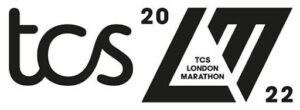
Keywords: injury, physiology, health
The Marathon Medicine conference returned to the RIBA London to celebrate its 38th edition on Saturday 1st October 2022. The event was organised in partnership with, and supported by, the TCS London Marathon and, had an international panel of experts discussing the medicine and science of endurance running. All talks have been recorded and are available from The Marathon Medicine Conference website.
What Makes Kipchoge so Good? The Fourth Dimension in the Physiology of Marathon Running
Professor Andy Jones started with a brief summary of the three main physiological characteristics widely accepted to determine marathon performance: maximum oxygen uptake (VO2max), lactate threshold, and running economy, which may be integrated as the critical speed (1). Prof. Jones presented data from world-class male distance runners, who were thought to be able to break the mythical barrier of running a marathon in under 2 hours. The paper, which has attracted over 25,000 downloads, demonstrates that, unsurprisingly, elite endurance runners are very, very fit! They achieved a VO2max of ~72 mL/kg/min, reaching the lactate threshold at ~94% of their VO2max, and could run at 2-h marathon pace with an O2 cost of only ~190 mL/min/kg. However, although 7 athletes were able to reach a steady state at 2-h marathon pace, and thus theoretically being able to break the 2-h marathon barrier, only Eliud Kipchoge, arguably the greatest marathon runner of all time, has been able to run the 26.2 miles in less than 2 hours (1:59:40). This may be explained by the fact that physiological characteristics are not static, but deteriorate, as demonstrated by the reduction in critical speed during prolonged exercise (2). Indeed, the concept of durability, or resilience, has been recently suggested to account for the ability of runners to resist such changes and preserve their physiological characteristics, which indeed appears to contribute to explain marathon performance (3, 4). In addition to VO2max, lactate threshold, and running economy, the concept of durability (or resilience), may be considered as the fourth parameter of endurance performance.
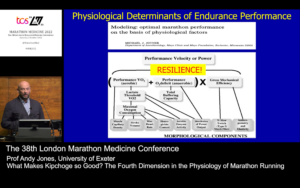
The aetiology of bone stress fractures in female athletes
The second talk of the day was delivered by Professor Julie Greeves OBE, on the aetiology of bone stress injuries in female athletes. The talk explored the first reports of stress fractures in Prussian soldiers by Breithaupt in 1855, who termed these injuries as march fractures (5). We now know, however, that bone stress injuries (BSI) happen in a continuum, from stress reaction to complete fracture, and that female runners have a higher risk of BSI than their male counterparts. There are a myriad of factors to explain the higher risk of BSI in females, which may be related to the Relative Energy Deficiency in Sport (RED-S) (6). The concept of RED-S, describing a total energy expenditure in excess of energy intake, is broader than that of the Female Athlete Triad. It encompasses a wide range of health outcomes, including physical and cognitive performance, as well as wider populations, including non-athletes and men. One such population is military personnel (7), who may drop into energy deficiency during periods of intense training or combat, and as a result experience impaired bone health, which ultimately can result in an increased risk of BSI. Prof Greeves discussed practical strategies (8) that may improve bone health, and reduce the risk of BSI. Such strategies may include managing training load, nutritional strategies, and better screening, but also would need to consider cultural barriers.
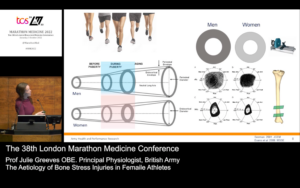
The postpartum runner: A unique opportunity to prepare for injury
The third speaker of the morning was Dr Isabel Moore. This talk reminded us, as a community of sports medicine and sport and exercise science specialists, we need to focus more on female research. Whilst there is a wealth of research on the male sex, there are only 35% to 37% female participants per article across sport and exercise journals (9). The shortage of female-specific data is likely the result of the inability, or lack of willingness, to effectively adapt experimental designs to incorporate female-specific considerations, such as the menstrual cycle, hormonal contraceptive use, pregnancy, and the menopause. This affects the lack of female-specific perspective studies, addressing issues that affect specifically the female sex, such as pregnancy. Dr Moore discussed novel approaches to record and report injuries and illnesses, with a novel framework that may be implemented during pregnancy, in preparation for their postpartum rehabilitation and eventual return to work. The 6 Rs framework is one such approach, which aims to get athletes Ready for the anticipated changes associated with pregnancy and partum, Review and evaluate the postpartum athlete, Restore physical and psychological well-being, Recondition in order to be able to cope with the physical and psychological demands of the sport or activity so that athletes can, eventually, Return to sport, and strategies can be Refined, if needed (10).
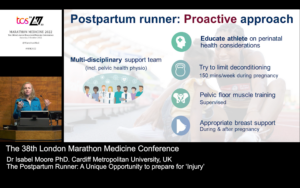
Strategies to Improve Durability of the Masters Runners
After a comfort break, Dr Richard Willy delivered a talk on the fastest growing segment of marathon runners, the master athlete, now representing over 50% of all marathon finishers. Ageing is characterised by a myriad of changes, affecting multiple physiological systems. Even if a decline in aerobic function and muscle strength seems inevitable with ageing, running can slow down the process. However, endurance running may not be enough, and a decline in running performance still happens as we age due to multiple reasons; declining cardiovascular function, reduced muscular capacity, altered biomechanics (11). As a result, master athletes tend to have greater susceptibility to running injuries, primarily, from soft-tissue injuries to the lower leg and foot. This includes Achilles tendinopathy, the most common running-related injury experienced by master runners, as well as calf strains and plantar fasciopathy. Simple, yet effective, interventions addressing soft tissue injuries were discussed during the talk (such as heavy slow seated calf raises to optimise soleus strength), which may be used to reduce the risk of injury in the master athlete.
Cardiovascular effects of endurance exercise: Mainly good but some concerns
Professor Sanjay Sharma closed this year’s conference with a talk addressing the cardiovascular effects of endurance exercise. Prof. Sharma started the talk with a brief summary of the indisputable benefits that regular endurance exercise has on the cardiovascular system. Prof. Sharma reminded the audience that the recommended guidelines for physical activity, 150 min of moderate exercise per week, should be the bare minimum we aim for! Indeed, those who manage to accumulate 3-5 times this amount of endurance exercise per week experience greater benefits to health. However, the talk revolved around those who significantly exceed these recommendations (up to 10-15 times the recommended guidelines, or 25 hours per week), namely endurance athletes. Emerging data indicates that long-standing vigorous exercise may be associated with adverse electrical and structural remodelling in otherwise normal hearts (12). The significance of these data remains to be fully elucidated. However, the scarring within the heart and increased calcification within the coronary artery may pose a higher risk of atrial fibrillation, particularly in middle-aged, older male endurance runners (13). In summary, endurance exercise is undoubtedly beneficial to the cardiovascular system, yet some concerns may exist, particularly to those in the upper limit of the endurance exercise continuum.
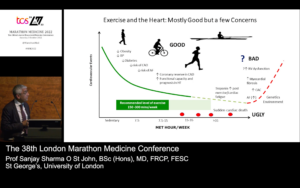
The 39th Marathon Medicine Conference will take place on 22nd April 2023.
By Dr Daniel Muniz, University of Hertfordshire
No competing interests
d.muniz@herts.ac.uk
Twitter: @Daniel_Muniz_
References
- Jones AM, Burnley M, Black MI, Poole DC, and Vanhatalo A. The maximal metabolic steady state: redefining the ‘gold standard’. Physiological Reports 7: e14098, 2019.
- CLARK IE, VANHATALO A, BAILEY SJ, WYLIE LJ, KIRBY BS, WILKINS BW, and JONES AM. Effects of Two Hours of Heavy-Intensity Exercise on the Power–Duration Relationship. Medicine & Science in Sports & Exercise 50: 1658-1668, 2018.
- Maunder E, Seiler S, Mildenhall MJ, Kilding AE, and Plews DJ. The Importance of ‘Durability’ in the Physiological Profiling of Endurance Athletes. Sports Medicine 51: 1619-1628, 2021.
- Smyth B, Maunder E, Meyler S, Hunter B, and Muniz-Pumares D. Decoupling of Internal and External Workload During a Marathon: An Analysis of Durability in 82,303 Recreational Runners. Sports Medicine 52: 2283-2295, 2022.
- Astur DC, Zanatta F, Arliani GG, Moraes ER, Pochini AdC, and Ejnisman B. Stress fractures: definition, diagnosis and treatment. Rev Bras Ortop 51: 3-10, 2015.
- Mountjoy M, Sundgot-Borgen J, Burke L, Carter S, Constantini N, Lebrun C, Meyer N, Sherman R, Steffen K, Budgett R, and Ljungqvist A. The IOC consensus statement: beyond the Female Athlete Triad–Relative Energy Deficiency in Sport (RED-S). Br J Sports Med 48: 491-497, 2014.
- O’Leary TJ, Wardle SL, and Greeves JP. Energy Deficiency in Soldiers: The Risk of the Athlete Triad and Relative Energy Deficiency in Sport Syndromes in the Military. Frontiers in Nutrition 7: 2020.
- O’Leary TJ, Rice HM, and Greeves JP. Biomechanical Basis of Predicting and Preventing Lower Limb Stress Fractures During Arduous Training. Current Osteoporosis Reports 19: 308-317, 2021.
- Costello JT, Bieuzen F, and Bleakley CM. Where are all the female participants in Sports and Exercise Medicine research? European Journal of Sport Science 14: 847-851, 2014.
- Donnelly GM, Moore IS, Brockwell E, Rankin A, and Cooke R. Reframing return-to-sport postpartum: the 6 Rs framework. British Journal of Sports Medicine 56: 244-245, 2022.
- Willy RW, and Paquette MR. The Physiology and Biomechanics of the Master Runner. Sports Medicine and Arthroscopy Review 27: 15-21, 2019.
- Sharma S, Merghani A, and Mont L. Exercise and the heart: the good, the bad, and the ugly. Eur Heart J 36: 1445-1453, 2015.
- Parry-Williams G, Gati S, and Sharma S. The heart of the ageing endurance athlete: the role of chronic coronary stress. Eur Heart J 42: 2737-2744, 2021.